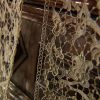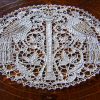Lace manufacture was resumed in Europe at the beginning of the 19th century by will of Napoleon who, seeing that thousands of professionals in the sector were jobless, made its use in court ceremonial robes compulsory. Lace production, which saw an unhoped-for rise in England, France, Belgium and Spain, proceeded instead wearily in Venice in the course of the 19th century, trying in vain to compete with the economical and apparently equally pretty mechanical lace, until its renewed launch in the last quarter of the century. Committees of intellectuals, politicians and cultured aristocratic ladies, Andriana Marcello in the first place, not only organised schools for learning by retrieving ancient designs and lace to copy, but most to the point, purchased those very expensive artefacts, without expecting favourable prices.
Such artistic activity revived everywhere (even in China through the missionaries), with alternate fortunes according to the whims of fashion, became anachronistic and antiquated in the post second war era. The winds of novelty coming from America first and from England afterwards, the student movements all over Europe, would spell its end. Having been recognised as a form of traditional craftsmanship to save and recuperate historically and technically, it would be resumed once more in the last quarter of the 20th century, and carried forward to our days thanks to the passion and goodwill of individual professional women in this sector.




